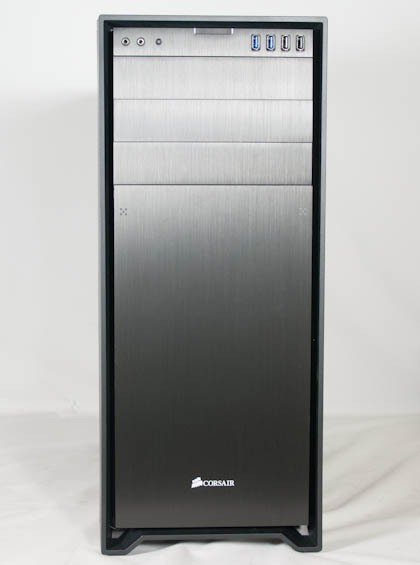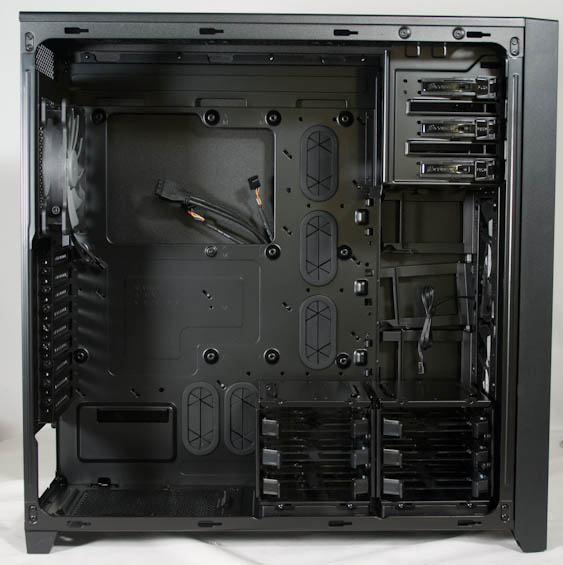Corsair Obsidian 750D Case Review
by Dustin Sklavos on September 24, 2013 6:00 AM EST- Posted in
- Cases/Cooling/PSUs
- Corsair
- ATX
- Case
_678x452.jpg)
Corsair's case lineup has been growing over time with a trickle down approach, as they launched with the venerable (and expensive) Obsidian 800D and have been able to shrink all the way down to the Carbide 200R. Yet outside of the Obsidian 900D, their enthusiast high end (as opposed to the obscene beast that is the 900D) has actually remained relatively unchanged. Today the Obsidian 750D launches, covering the space the 700D and 800D used to occupy while trickling down the 900D's industrial design.

The "lip" that was on the Graphite 600T has become a part of the ID for Corsair's new Obsidian cases, and I like it. Corsair has actually turned it into a fairly smart, useful design cue; there are no unsightly vents on the front fascia of the Obsidian 750D, but the large plate at the bottom is actually almost totally ventilated in the surrounding area. It's a slick design. The black aluminum fascia suits the 750D and allows it to stand out even amongst other "black monolith" style enclosures. Corsair has also taken to using large square windows on the sides of their cases, and these sharp angles suit the rest of the ID well. Whoever is handling ID over there should be proud.

The interior of the 750D is a pretty bog standard case design, but it sports all the usability I've come to expect from Corsair. Both 3.5" drive cages are removable (or stackable), and toolless 2.5" drive cages line the back off the case (one of mine was jostled slightly in shipment). Corsair has been experimenting both with doing away with 3.5" drives (the Carbide Air 540 only supports two) and toolless 2.5" drive mounting methods, but the fly in the ointment for the latter has been the increasing popularity of 7mm drives instead of 9.5mm ones.
Air cooling is handled by a pair of 140mm intake fans and a 140mm exhaust fan; there's space to mount additional fans (or radiators) in the top of the 750D as well, and a large magnetic "sheet filter" is in place on the top of the case. Interestingly, Corsair has forgone including a fan controller with the 750D; instead, the 140mm fans are just tuned to what will hopefully be a happy medium.
| Corsair Obsidian 750D Specifications | ||
| Motherboard Form Factor | Mini-ITX, Micro-ATX, ATX, EATX, XL-ATX | |
| Drive Bays | External | 3x 5.25" |
| Internal | 6x 2.5"/3.5", 4x 2.5" | |
| Cooling | Front | 2x 140mm intake fan (supports 2x 120mm) |
| Rear | 1x 140mm exhaust fan (supports 120mm) | |
| Top | 3x 120mm/2x 140mm fan mount | |
| Side | - | |
| Bottom | 2x 120mm fan mount (with 3.5" cages removed) | |
| Expansion Slots | 9 | |
| I/O Port | 2x USB 3.0, 2x USB 2.0, 1x Headphone, 1x Mic | |
| Power Supply Size | ATX | |
| Clearances | HSF | 180mm |
| PSU | 200mm with drive cages | |
| GPU | 340mm with drive cage / 460mm without | |
| Dimensions | 21.5" x 9.3" x 22.1" 546mm x 235mm x 560mm |
|
| Special Features | Removable drive cages Toolless 2.5" caddies |
|
| Price | $159 | |
The Obsidian 750D is essentially hitting the mainstream of the high end. This is a fairly competitive market, and it behooves Corsair to have a strong entry at the $159 price point. What's interesting is that while one of Corsair's main competitors, NZXT, is cramming their cases full of useful features, Corsair seems to be stripping them down to the essentials. The interior is primarily modular, sure, but there's no fan control, no acoustic padding, no funky LED lighting, nothing like that; this is a streamlined enclosure that seems to be heavily geared toward liquid cooling. That's fairly typical of modern Corsair designs; the 900D's entire reason for being is really to be a liquid cooled system, and the cumulative 1020mm of radiator support in the 750D should be fairly telling.


_thumb.jpg)
_thumb.jpg)
_thumb.jpg)
_thumb.jpg)
_thumb.jpg)
_thumb.jpg)








40 Comments
View All Comments
b3nzint - Tuesday, September 24, 2013 - link
Does it has a gpu holder mechanism? and I need 4 bay 5.25". But overall not bad.hemi79 - Wednesday, September 25, 2013 - link
This looks like a great case! I had the C70 and just felt the need for more space so I looked into to the Obsidian models, but the 650D model didn't convince me due to the 200mm fans. This seems like the perfect case for my case. I went with the NZXT Switch in Matte Black and while I had all the space I dreamed of, I have to say the quality of the build and material did not compare to the Corsair C70. I almost regretted it, but I made peace with my decision instead of paying return shipping. lolUltraWide - Saturday, September 28, 2013 - link
One thing you can't tell from the pictures and review is how flimsy this case is. The overall quality is very low, more in line with the Carbide series. The design and layout is excellent, but the metal is just too thin and the case frame/structure bends easily. I am returning mine and going with the NZXT H630.Cainethanatos - Monday, September 30, 2013 - link
Oh really, is it that bad ? I am aswell looking at the 750D or the H630 . Dustin, compared to the H630, the build quality better oir worse (or the same(ish) ). Otherwise I might need to flip a coin :)lorribot - Saturday, October 5, 2013 - link
Hands up anyone who would use all 10 HD drive bays? What about all three 5.25 bays?I do sometimes feel it is a case of "because we can, we will" when it comes to the number drive bays in cases. I imagine most people are likely to need no more than two, one 2.5 and one 3.5, some may need to use a 5.25 for fan controls or even a blue ray but to be honest I can't remember the last time I put a DVD into a computer.
It would be a brave case manufacture that dropped completely or only provided ony a single 5.25 bay (or low profile one) and only 2 or 3 2.5/3.5 multi use bays in anything other than an ITX case
But whatever the case size I would expect improved air flow without all the extra bits of metal spoiling things. It might even reduce prices a bit and simplify installations and provide more layout options internally.
This case like many others reviewed is safe, uninspiring and of little merit. Apart from the odd case that nudges at the boundaries there is nothing really happening in case design, it is ripe for some real design people to step in and provide some real inspiration and flair, sadly it seems that only Apple, albeit freed from the constraints of standard motherboard layouts, is up for the challenge.
limaxophobiac - Friday, October 11, 2013 - link
"Noise levels prove to be a victory for Corsair, but they're still struggling to beat NZXT's Phantom 630, which runs both quieter and cooler."This isn't true at all, look at the test, at Overclocked Load and Full Fat the CPU in the NZXT Phantom 630 is 8-10 degrees hotter, this is HUGE in the 750D favour.
limaxophobiac - Friday, October 11, 2013 - link
Nevermind I was looking at the H630 not the Phantom. The Phantom is indeed cooler.The_Goods - Tuesday, October 15, 2013 - link
I love the heck out of my 800D. It's a gorgeous space to build a veritable waterpark of cooling.When I don't love it, is when I have to pick up the 70lbs of PC manlove.
These new ones are going to make for some happy hooligans.
sdmf74 - Tuesday, October 22, 2013 - link
dude you have your SSD plugged in to your optical drive WTFAntonio Cortina - Monday, October 20, 2014 - link
I have this box for a week now and I've seen the HDD LED does not work :(Not know the Corsair RMA policy but they should change the box completely.
I've already put a complaint in the store but they doubt that the supplier's change me for another.
All Obsidian boxes I've had in the European area had a defect.
I hope Corsair fix this or lose a lot of customers